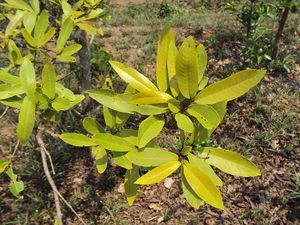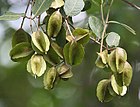Note: This is a project under development. The articles on this wiki are just being initiated and broadly incomplete. You can Help creating new pages.
Difference between revisions of "Terminalia arjuna - Arjuna, White Marudah"
m (Prabhakar moved page White Marudah (Terminalia arjuna) to Terminalia arjuna - White Marudah) |
|||
| Line 1: | Line 1: | ||
[[File:800px-Terminalia arjuna 07a.JPG|thumb|right|'' Nirmatti'', ''Terminalia arjuna'']] | [[File:800px-Terminalia arjuna 07a.JPG|thumb|right|'' Nirmatti'', ''Terminalia arjuna'']] | ||
| − | + | '''Terminalia arjuna''' is a tree of the genus Terminalia. The arjuna is about 20–25 metres tall; usually has a buttressed trunk, and forms a wide canopy at the crown, from which branches drop downwards. | |
| − | == | + | ==Uses== |
| + | {{Uses|Atherosclerosis}}, {{Uses|Coronary Artery Disease}}, {{Uses|Myocardial Infarction}}, {{Uses|Shortness of Breath}}, {{Uses|Angina Pectoris}}, {{Uses|Dyslipidemia}}, {{Uses|Hypercholesterolemia}}, {{Uses|Hemorrhages}}, {{Uses|Bone Fractures}} | ||
| + | |||
| + | ==Parts Used== | ||
| + | {{Parts Used|Dried Folaige}}, {{Parts Used|Whole herb}}. | ||
| + | |||
| + | ==Chemical Composition== | ||
| + | Main chemical constitutes are tannins, triterpenoid saponins (arjunic acid, arjunolic acid, arjungenin and arjunic acid), flavonoids, gallic acid, ellagic acid and phytosterols.<ref name="chemical composition"/> | ||
| + | |||
| + | ==Common names== | ||
| + | {{Common names|kn=|ml=NEER MARUTHU|sa=ARJUNA, ARJUN|ta=MARUDHA MARAM|te=THELLA MADDI|hi=ARJUNA, ARJUN|en=ARJUNA, ARJUN TREE}} | ||
| + | |||
| + | ==Properties== | ||
| + | Reference: Dravya - Substance, Rasa - Taste, Guna - Qualities, Veerya - Potency, Vipaka - Post-digesion effect, Karma - Pharmacological activity, Prabhava - Therepeutics. | ||
| + | ===Dravya=== | ||
| + | |||
| + | ===Rasa=== | ||
| + | Tikta (Bitter), Kashaya (Astringent) | ||
| + | ===Guna=== | ||
| + | Laghu (Light), Ruksha (Dry), Tikshna (Sharp) | ||
| + | ===Veerya=== | ||
| + | Ushna (Hot) | ||
| + | ===Vipaka=== | ||
| + | Katu (Pungent) | ||
| + | ===Karma=== | ||
| + | Kapha, Vata | ||
| + | ===Prabhava=== | ||
| + | |||
| + | ==Habit== | ||
| + | {{Habit|Tree}} | ||
| + | |||
| + | ==Identification== | ||
| + | ===Leaf=== | ||
| + | {{Leaf|Simple|alternate|Conical and oblong leaves. Leaves have a green color on the top and brown color below.}}<ref name="Leaf"/> | ||
| + | |||
| + | ===Flower=== | ||
| + | {{Flower|Unisexual|2-4cm long|Yellow|5|Flowering Time is March and June}} | ||
| + | |||
| + | ===Fruit=== | ||
| + | {{Fruit|General|2 to 5 cm|Fruition Time Between September to November|It has fibrous woody fruits|many}} | ||
| + | |||
| + | ===Other features=== | ||
| + | |||
| + | ==List of Ayurvedic medicine in which the herb is used== | ||
| + | * [[Vishatinduka Taila]] as ''root juice extract'' | ||
| + | |||
| + | ==Where to get the saplings== | ||
| + | ==Mode of Propagation== | ||
| + | {{Propagation|Seeds}}, {{Propagation|Cuttings}}. | ||
| + | |||
| + | ==How to plant/cultivate== | ||
| + | Its fruit is dried in the sunlight and than stored up to 6 -12 months. Seeds are pretreated by soaking in the water for 48 hours before sowing in beds.<ref name="How to plant/cultivate"/> | ||
| + | |||
| + | ==Commonly seen growing in areas== | ||
| + | {{Commonly seen|humid areas}}, {{Commonly seen|fertile and red lateritic soils}}, {{Commonly seen|Borders of forests and fields}}. | ||
| + | |||
| + | ==Photo Gallery== | ||
| + | <gallery class="left" caption="" widths="140px" heights="140px"> | ||
| − | + | Bark with Immature Oriental Magpie Robin I IMG 7827.jpg | |
| − | + | ||
| + | Flowers with Sykes's warbler I IMG 1880.jpg | ||
| − | + | ||
| + | Fruit I IMG 9577.jpg | ||
| − | + | ||
| + | Kosa Silk Culture at Raigarh.jpg | ||
| − | |||
| − | |||
| − | |||
| − | + | (Terminalia Arjuna) tree at Vivekananda park in Kakinada.jpg | |
| + | |||
| − | <references> | + | Anjantree.JPG |
| − | <ref name=" | + | |
| + | |||
| + | Bark - Terminalia arjuna - Indian Botanic Garden - Howrah 2013-03-31 5734.JPG | ||
| + | |||
| + | </gallery> | ||
| + | |||
| + | ==References== | ||
| + | |||
| + | <references> | ||
| + | <ref name="chemical composition">[http://www.motherherbs.com/terminalia-arjuna-extract.html "Chemical Constituents"]</ref> | ||
| + | |||
| + | <ref name="Leaf">[https://www.ayurtimes.com/terminalia-arjuna-arjun-tree/ "plant description"]</ref> | ||
| + | |||
| + | <ref name="How to plant/cultivate">[http://www.ecoindia.com/flora/trees/arjun-tree.html "Cultivation methods"]</ref> | ||
</references> | </references> | ||
| − | == External Links == | + | ==External Links== |
| + | * [https://www.sciencedirect.com/science/article/pii/S2225411016000262 Medicinal properties of Terminalia arjuna (Roxb.) Wight & Arn.: A review] | ||
| + | * [https://examine.com/supplements/terminalia-arjuna/ Summary of Terminalia arjuna] | ||
| + | * [http://www.worldagroforestry.org/treedb2/speciesprofile.php?Spid=18136 Terminalia arjuna on world agro forestry.org] | ||
| − | |||
[[Category:Herbs]] | [[Category:Herbs]] | ||
Revision as of 11:28, 11 June 2018
Terminalia arjuna is a tree of the genus Terminalia. The arjuna is about 20–25 metres tall; usually has a buttressed trunk, and forms a wide canopy at the crown, from which branches drop downwards.
Contents
- 1 Uses
- 2 Parts Used
- 3 Chemical Composition
- 4 Common names
- 5 Properties
- 6 Habit
- 7 Identification
- 8 List of Ayurvedic medicine in which the herb is used
- 9 Where to get the saplings
- 10 Mode of Propagation
- 11 How to plant/cultivate
- 12 Commonly seen growing in areas
- 13 Photo Gallery
- 14 References
- 15 External Links
Uses
Atherosclerosis, Coronary Artery Disease, Myocardial Infarction, Shortness of Breath, Angina Pectoris, Dyslipidemia, Hypercholesterolemia, Hemorrhages, Bone Fractures
Parts Used
Chemical Composition
Main chemical constitutes are tannins, triterpenoid saponins (arjunic acid, arjunolic acid, arjungenin and arjunic acid), flavonoids, gallic acid, ellagic acid and phytosterols.[1]
Common names
| Language | Common name |
|---|---|
| Kannada | |
| Hindi | ARJUNA, ARJUN |
| Malayalam | NEER MARUTHU |
| Tamil | MARUDHA MARAM |
| Telugu | THELLA MADDI |
| Marathi | NA |
| Gujarathi | NA |
| Punjabi | NA |
| Kashmiri | NA |
| Sanskrit | ARJUNA, ARJUN |
| English | ARJUNA, ARJUN TREE |
Properties
Reference: Dravya - Substance, Rasa - Taste, Guna - Qualities, Veerya - Potency, Vipaka - Post-digesion effect, Karma - Pharmacological activity, Prabhava - Therepeutics.
Dravya
Rasa
Tikta (Bitter), Kashaya (Astringent)
Guna
Laghu (Light), Ruksha (Dry), Tikshna (Sharp)
Veerya
Ushna (Hot)
Vipaka
Katu (Pungent)
Karma
Kapha, Vata
Prabhava
Habit
Identification
Leaf
| Kind | Shape | Feature |
|---|---|---|
| Simple | alternate | Conical and oblong leaves. Leaves have a green color on the top and brown color below. |
Flower
| Type | Size | Color and composition | Stamen | More information |
|---|---|---|---|---|
| Unisexual | 2-4cm long | Yellow | 5 | Flowering Time is March and June |
Fruit
| Type | Size | Mass | Appearance | Seeds | More information |
|---|---|---|---|---|---|
| General | 2 to 5 cm | Fruition Time Between September to November | It has fibrous woody fruits | many | {{{6}}} |
Other features
List of Ayurvedic medicine in which the herb is used
- Vishatinduka Taila as root juice extract
Where to get the saplings
Mode of Propagation
How to plant/cultivate
Its fruit is dried in the sunlight and than stored up to 6 -12 months. Seeds are pretreated by soaking in the water for 48 hours before sowing in beds.[3]
Commonly seen growing in areas
humid areas, fertile and red lateritic soils, Borders of forests and fields.
Photo Gallery
References
External Links
- Ayurvedic Herbs known to be helpful to treat Atherosclerosis
- Ayurvedic Herbs known to be helpful to treat Coronary Artery Disease
- Ayurvedic Herbs known to be helpful to treat Myocardial Infarction
- Ayurvedic Herbs known to be helpful to treat Shortness of Breath
- Ayurvedic Herbs known to be helpful to treat Angina Pectoris
- Ayurvedic Herbs known to be helpful to treat Dyslipidemia
- Ayurvedic Herbs known to be helpful to treat Hypercholesterolemia
- Ayurvedic Herbs known to be helpful to treat Hemorrhages
- Ayurvedic Herbs known to be helpful to treat Bone Fractures
- Herbs with Dried Folaige used in medicine
- Herbs with Whole herb used in medicine
- Herbs with common name in Hindi
- Herbs with common name in Malayalam
- Herbs with common name in Tamil
- Herbs with common name in Telugu
- Herbs with common name in Sanskrit
- Herbs with common name in English
- Habit - Tree
- Index of Plants which can be propagated by Seeds
- Index of Plants which can be propagated by Cuttings
- Herbs that are commonly seen in the region of humid areas
- Herbs that are commonly seen in the region of fertile and red lateritic soils
- Herbs that are commonly seen in the region of Borders of forests and fields
- Herbs







